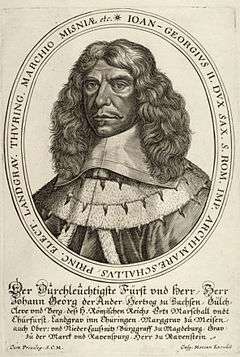John George II, Elector of Saxony
| John George II | |
|---|---|
|
Portrait by Johann Finck, 1675. | |
| Elector of Saxony | |
| Reign | 8 October 1656 – 22 August 1680 |
| Predecessor | John George I |
| Successor | John George III |
| Born |
31 May 1613 Dresden |
| Died |
22 August 1680 (aged 67) Tübingen |
| Burial | Cathedral of Freiberg |
| Spouse | Magdalene Sybille of Brandenburg-Bayreuth |
| Issue | John George III, Elector of Saxony |
| House | House of Wettin |
| Father | John George I, Elector of Saxony |
| Mother | Magdalene Sybille of Prussia |
| Religion | Lutheranism |
John George (31 May 1613 – 22 August 1680) was the Elector of Saxony from 1656 to 1680. He belonged to the Albertine line of the House of Wettin.
Biography
He was the third (fourth in order of birth) but eldest surviving son of the Elector John George I of Saxony[1] and Magdalene Sybille of Prussia, his second spouse. He succeeded his father as Elector of Saxony when John George I died on 8 October 1656.[2]
In 1657 John George made an arrangement with his three brothers with the object of preventing disputes over their separate territories, and in 1664 he entered into friendly relations with Louis XIV. He received money from the French king, but the existence of a strong anti-French party in Saxony induced him occasionally to respond to the overtures of the emperor Leopold I.[1]

The elector's primary interests were not in politics, but in music and art. He adorned Dresden, which under him became the musical centre of Germany; welcoming foreign musicians and others he gathered around him a large and splendid court, and his capital was the constant scene of musical and other festivals.[1] He commissioned the building of the first opera house, the Opernhaus am Taschenberg.
In 1658 John George was accepted into the Fruitbearing Society, through the patronage of Duke William of Saxe-Weimar.
His enormous expenditure on the arts compelled John George in 1661 to grant greater control over monetary matters to the estates, a step which laid the foundation of the later system of finance in Saxony. Also, his government was less effective in establishing absolutist rule and a standing army than were Bohemia or Prussia.[1]
John George's reign saw the slow economic reconstruction of Saxony after the Thirty Years' War. New trades and manufactures developed, such as textiles, hard coal and glass. Locally mined silver filled the Electorate's empty treasury, and the Leipzig Trade Fair and the Bohemian Exulanten of 1654 also stimulated economic activity.
John George died in Freiberg on 22 August 1680.[1]
Family
In Dresden on 13 November 1638 John George married Magdalene Sibylle of Brandenburg-Bayreuth. They had three children:
- Sibylle Marie (16 September 1642 – 27 February 1643)
- Erdmuthe Sophie (25 February 1644 – 22 June 1670), married on 29 October 1662 to Christian Ernst, Margrave of Brandenburg-Bayreuth
- John George III (20 June 1647 – 12 September 1691), his successor as Elector.
Ancestors
Notes
- 1 2 3 4 5 Chisholm 1911, p. 459.
- ↑ See the Encyclopaedia Britannica article on John George I for his date of death—immediately before the article on John George II (Chisholm 1911, p. 459).
References
- Mary E. Frandsen: Crossing Confessional Boundaries. The Patronage of Italian Sacred Music in 17th Century Dresden. New York: Oxford University Press, 2006. ISBN 0-19-517831-9
- Attribution
 This article incorporates text from a publication now in the public domain: Chisholm, Hugh, ed. (1911). "John George II". Encyclopædia Britannica. 15 (11th ed.). Cambridge University Press. p. 459.
This article incorporates text from a publication now in the public domain: Chisholm, Hugh, ed. (1911). "John George II". Encyclopædia Britannica. 15 (11th ed.). Cambridge University Press. p. 459.
| John George II, Elector of Saxony Born: 31 May 1613 Died: 22 August 1680 | ||
| Preceded by John George I |
Elector of Saxony 1656–1680 |
Succeeded by John George III |
